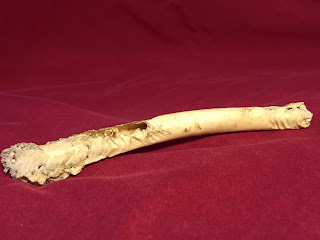Dive! Dive!
These are what human rib bones look like. No real surprises here, a series of thin, curved bones, designed to protect your most important organs, like your heart and lungs. What is surprising and kinda creepy is that I got this image from Pintrest, where these real bones are for sale. Just smile and walk away, Katie, pretend you didn't see anything and avoid eye contact. Now take a look at this rib bone:
Look at how thick it is! The thickness is disproportionate to the size; this is not some dinosaur or elephant bone. So whose is it and why is it so thick? This is the rib bone of the Florida manatee, aka "sea cow."
Manatees are slow moving marine mammals that spend their days at the bottom of waterways, grazing on sea grasses. If a human wanted to lay on the bottom of the Gulf of Mexico, they would need to wear scuba dive weights to help them descend. Manatees have their dive weights built right in! Their super heavy and dense skeletons make it much easier to bob along on the bottom of the beautiful briny sea (extra points if you got the reference!). And if you're wondering how a manatee's body counteracts the weight of its skeleton in order to surface to breathe, manatees have extra long lungs along their back to aid in buoyancy.
Two Clues in One
Here we have another mystery bone, this one with two stories to tell. First, let's take a closer look at that hole on top.
Unlike the manatee's solid rib, this bone is hollow, meaning it can only belong to one kind of animal: a bird! Almost every single aspect of a bird's anatomy comes back to weight reduction in order to achieve flight. Bird's skeletons are hollow, but still have criss-cross struts for reinforcement, just like an airplane's wings. This particular bone came from the wing of a brown pelican. Now let's look at another clue by zooming in on the left side of the bone.
See all those scrape marks? Those aren't a normal feature of this bone, they came after the pelican died and its tissues decomposed. These are chew marks from a rodent! In the wild, animals don't have Flintstones vitamins in order to get the calcium they need, they get it from eating bones. This not only gives the chewer calcium, but also helps break down and dispose of animal carcasses. Rats, mice, squirrels, even deer and pigs will all chew on bones and leave their telltale clues behind.
Super Sensors
Another bird bone, this one is the beak of a roseate spoonbill, a gorgeous resident of Florida that is often mistaken for a flamingo due to its bright pink feathers.
Spoonbills wave their beak back and forth in the water while holding it slightly open in order to find their food. Instead of relying on their sense of sight to tell them when to snap their bill shut, they instead use a keen sense of touch. When we look closer at the underside of this spoony's beak, we can see hundreds of small holes where nerves permeate it, especially at the tip.
Fish don't stand a chance.
A Successful Defense (but he still died anyway)
Strong and sturdy, a turtle's shell is its ultimate defense from predators. The shell is a part of its skeleton, and is the result of widened and fused ribs, which are attached to the central backbone. When a turtle is withdrawn into its shell, it is protected from the bite of most predators, including raccoons, bobcats, and even...alligators.
Check this out:
On the back of this shell, you'll see three holes, the middle of which even has a scrape mark. And when we look on the bottom of the shell...
Three more tooth marks, complete with scrapes too! This turtle was one baaaad shut your mouth! It survived an attack from an alligator! How do we know it survived? Well unlike raccoons and bobcats, who can still use their paws to claw at a retracted turtle, alligators eat turtles by crushing their shells in their jaws. Because the shell is intact, we know this didn't happen. We also know that the turtle wasn't just swallowed whole because an alligator's stomach is capable of dissolving bone, so this isn't a shell that was pooped out. Just as well too, because this is a big shell and that sucker would hurt on the way out. We may not know what killed this turtle in the end, but we know it wasn't an alligator!
We may think of skulls as the most interesting part of an animal's skeleton, but all bones, no matter how small or mundane-looking, can tell stories of life and death. The next time you find an animal bone, go all CSI on it and see what you can figure out. Just don't sell any human bones you find on Pintrest, ok? That's still creeping me out.



















